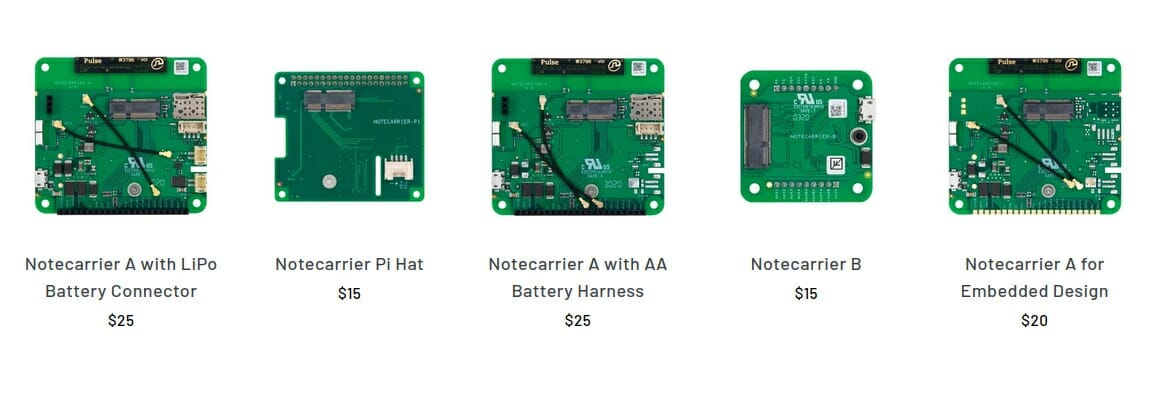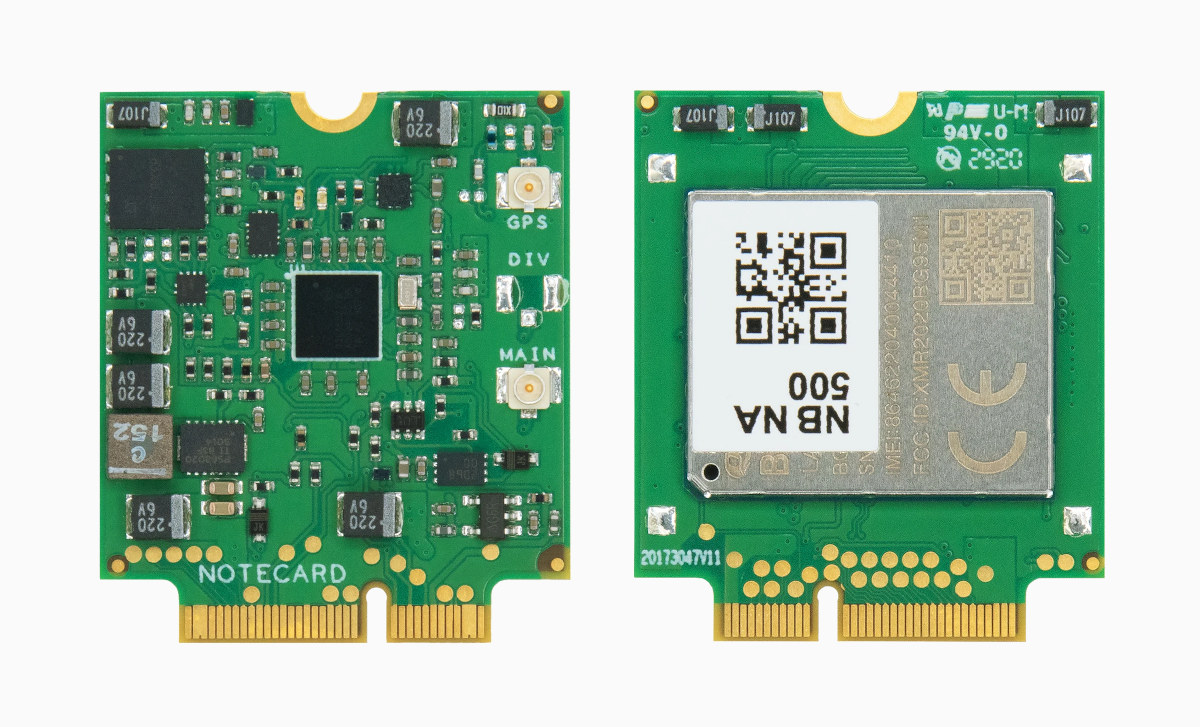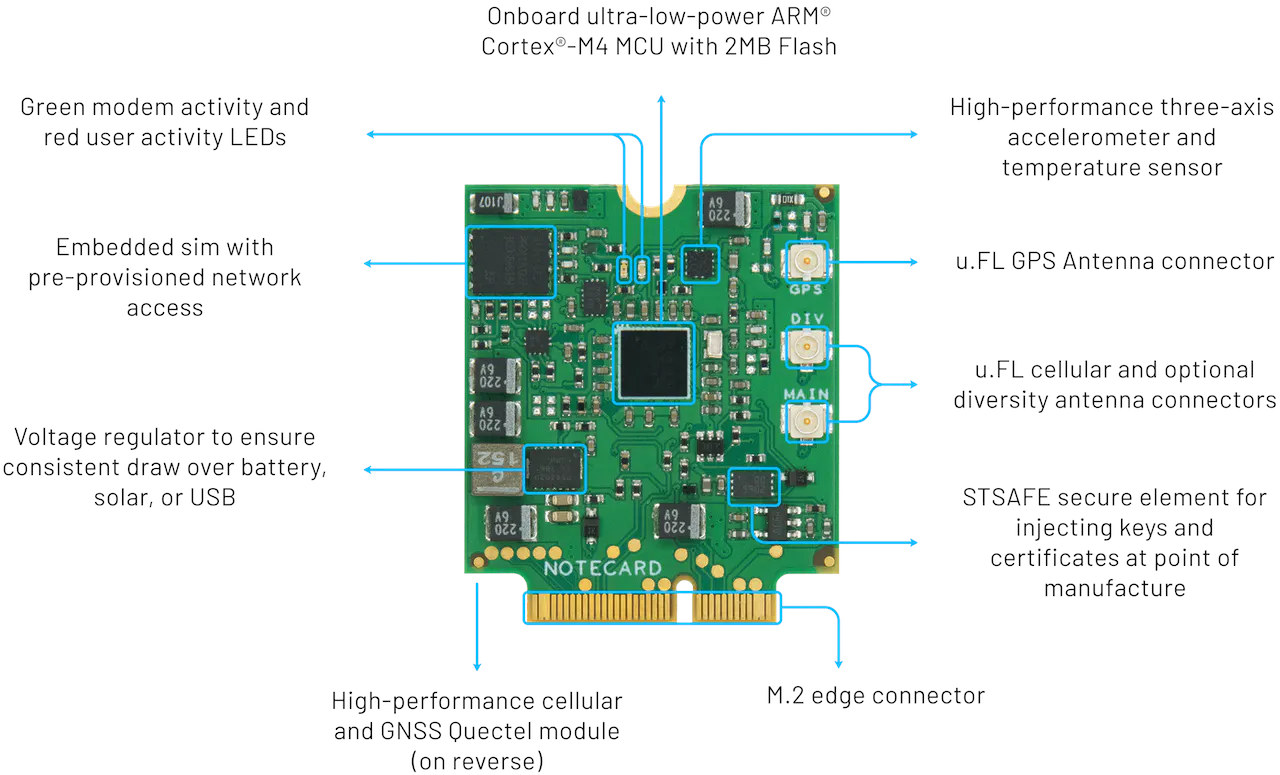If the IoT is ever going to take off, it needs low-cost hardware and connectivity. LoRaWAN is free, apart from the hardware costs, but for projects that need wider coverage and/or higher bitrate cellular connectivity is the way to go and we’ve seen in the past that Hologram offers a free developer SIM card for global IoT projects plus some low-cost cellular IoT plans, as well as 1CNE plans to offer a 10-year plan for 10 Euros.
Blues Wireless has taken a different approach as they combine hardware and cellular connectivity with their Notecard LTE-IoT modems (LTE Cat 1/Cat M or NB-IoT) shipping for 10 years of connectivity for up to 500MB data.
Notecard has four variants with the following key features and specifications:
- MCU – Arm Cortex-M4 MCU with 2MB flash
- Cellular connectivity
- NOTE-NBGL-500 – Narrowband Cat-M/NB-IoT/GPRS (Global) via Quectel BG95-M3 modem
- NOTE-NBNA-500 – Narrowband Cat-M/NB-IoT (North America) via Quectel BG95-M1 modem
- NOTE-WBEX-500 – LTE Cat-1 (Global) via Quectel EG91-EX modem
- NOTE-WBNA-500 – Wideband LTE Cat-1 (North America) via Quectel EG91-NAX modem
- Embedded SIM onboard
- 2x u.FL connectors for cellular plus optional diversity antenna
- GNSS – Integrated GPS (part of Quectel module) with u.FL GPS antenna connector
- Sensor – 3-axis accelerometer and temperature sensor
- Security – STSAFE Secure element with a factory-installed ECC P-384 certificate provisioned at chip manufacture.
- Host Interface – M.2 edge connector
- Misc – Modem and user LED’s
- Power Supply – Built-in voltage regulator supporting USB, battery, or solar inputs
- Power Consumption – Designed to operate on battery power, be “always-on” to maintain time & location, while typically drawing less than 8µA, when idle.
- Dimensions – 35 x 30mm
- PTCRB Certifications
All modules are bundled with 10-years and 500MB of cellular data. There’s no need to pay for cellular subscriptions, SIM fees nor monthly minimums.
The company also offers a range of carrier boards for people not wanting to design their own custom baseboards for Notecard M.2 module that include support for LiPo or AA battery, Raspberry Pi HAT, a minimal board with micro USB, and one model designed for “embedded design”, meaning integration into end products.
 Most modem modules rely on an AT command set, but Blues Wireless provides a modern JSON interface to send to/receive from the MCU using I2C, Serial, or USB, or connect to the cloud over HTTPS. All JSON messages are automatically tagged with date/time, tower, and GPS locations. The module can be controlled from a terminal CLI or a web browser. (but not Firefox apparently, and you’ll need Chrome, Brave, or Edge). The company also provides Notehub secure cloud service that the Notecard can use to send and receive data and also includes a console for fleet management, as well as secure connectors for routing data to third-party cloud applications. You can check out how to get started on the documentation website.
Most modem modules rely on an AT command set, but Blues Wireless provides a modern JSON interface to send to/receive from the MCU using I2C, Serial, or USB, or connect to the cloud over HTTPS. All JSON messages are automatically tagged with date/time, tower, and GPS locations. The module can be controlled from a terminal CLI or a web browser. (but not Firefox apparently, and you’ll need Chrome, Brave, or Edge). The company also provides Notehub secure cloud service that the Notecard can use to send and receive data and also includes a console for fleet management, as well as secure connectors for routing data to third-party cloud applications. You can check out how to get started on the documentation website.
Blues Wireless Notecard sells for $49 to $69 depending on the model, but all include a 10-year data plan with 500 MB, and the Notecarrier boards are available for $15 to $20.
Via Hackster.io

Jean-Luc started CNX Software in 2010 as a part-time endeavor, before quitting his job as a software engineering manager, and starting to write daily news, and reviews full time later in 2011.
Support CNX Software! Donate via cryptocurrencies, become a Patron on Patreon, or purchase goods on Amazon or Aliexpress








Interesting card for a 6LoWPAN Gateway.
Hologram offers service in “hundreds of countries”, but CAT-M1 is available only in US.
Blues Wireless also offers service in “135+ global markets”, but there is no list of countries for which CAT-M1/NB-IOT is available (probably also only in US).
Global support works with traditional LTE, but NB-IoT and Cat-M1 may be an issue. For example, I can use my Hologram card with 3G/4G networks, it did not work with NB-IoT last time I tried, and it was confirmed to me it was normal.
AFAIK…
M1 was designed as a simplification of regular LTE, so roaming works in a similar way to existing systems. Whether a telco supports this or not is another question, but I have personally used several M1 SIM cards with roaming.
NB1 on the other hand was designed to give up a lot of this compatibility for increased range, cheaper radios and lower power consumption. As far as I know, no telcos support NB1 roaming anywhere.
Does it work with Nvidia Jetson Xavier NX?
What kind of M.2 edge connector is shown in the photos? That does not look like M.2 connectors shown at https://en.wikipedia.org/wiki/M.2#Form_factors_and_keying.